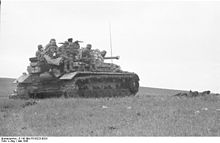- Crimean Campaign
-
Naval warfare
Baltic Sea - Black Sea - Arctic - (Arctic Convoys - Rösselsprung - Wunderland)
1941
Barbarossa - (Białystok and Minsk - Smolensk - Uman - Leningrad - 1st Kiev - Sevastopol - Rostov - Moscow) - Finland - Chechnya
1942
Battles of Rzhev - (Toropets and Kholm - Demyansk - Velikiye Luki - Mars) - 2nd Kharkov - Case Blue - Stalingrad - (Uranus - Winter Storm)
1943
3rd Kharkov - Kursk - 2nd Smolensk - Lower Dnieper - 2nd Kiev
1944
Dnieper and Carpathian - Leningrad and Novgorod - Narva - Hube's Pocket - Crimea - Jassy-Kishinev - Karelia - Bagration - Lvov and Sandomierz - 2nd Jassy-Kishinev - Baltics - Debrecen - Petsamo and Kirkenes - Hungary
1945
Vistula and Oder - East Prussia - East Pomerania - Solstice - Silesia - Vienna - Berlin - Czechoslovakia - German capitulationBrest – Bialystok-Minsk – Raseiniai – Brody – Bessarabia – Smolensk – Uman – 1st Kiev – Tallinn – Yelnya – Odessa – Leningrad – 1st Kharkov – 1st Crimea – 1st Rostov – Moscow1st Crimea – Kerch Peninsula – Adzhimushkay – Sevastopol – Caucasus – Kerch–Eltigen Operation (1943) – 2nd CrimeaThe Crimea Campaign was an eight month long campaign of the Axis forces to conquer the Crimea peninsula, and was the scene of some of the bloodiest battles on the Eastern Front during World War II. The German and Romanian troops suffered heavy casualties as they tried to advance through the isthmus linking the Crimean peninsula to the mainland at Perekop, from summer of 1941 through to the first half of 1942.
From the 26 September 1941 the German 11th Army and troops from the Romanian Third Army and Fourth Army were involved in the fighting,[1] opposed by the Red Army's 51st Army and elements of the Black Sea Fleet. After the campaign, the peninsula was occupied by Army Group A with the 17th Army as its major subordinate formation.[2]
Once the Axis (German and Romanian troops) broke through, they occupied most of Crimea, with the exception of the city of Sevastopol (given the title of Hero City later) and Kerch, which was recaptured by the Soviets during an amphibious operation near the end of 1941 and then once again by Germans during Operation Bustard Hunt on 8 May.[1][3] Sevastopol held out for 250 days from 30 October 1941 until 4 July 1942, when the Germans finally captured the city.
 German Panzer IV tank and soldiers in the Crimea, 1942.
German Panzer IV tank and soldiers in the Crimea, 1942.
In 1944, Crimea was recaptured by the troops of the 4th Ukrainian Front during the Crimean Offensive (8 April 1944 - 12 May 1944) and its three sub-operations:
- Kerch–Eltigen Operation (31 October 1943 - 11 December 1943)
- Perekop-Sevastopol Offensive Operation (8 April 1944 - 12 May 1944)
- Kerch-Sevastopol Offensive Operation (11 April 1944 - 12 May 1944)
Contents
Siege of Sevastopol
Main article: Siege of Sevastopol (1941-1942)The main object of the Campaign, Sevastopol was surrounded by German forces an assaulted on 30 October 1941. German troops were repulsed by a Soviet counter-attack, which was latter supported by many troops evacuated from Odessa. The Germans then began an encirclement of the city.[1] Other attacks on 11 November and 30 November, in the eastern and southern sectiotns of the city, failed.[1] Germany was then reinforced by several artillery regiments, one of which included the railway gun Schwerer Gustav.[1] Another attack on 17 December was repulsed at the last moment with the help of reinforcements, and Soviet troops soon started landing on the Kerch peninsula the day after Christmas, to draw German forces away from Sevastopol.[1] The army made progress until a 9 April German counterattack.[1] The Soviet forces held on for another month before being captured on 18 May. With the distraction removed, German forces renewed their assault on Sevastopol, penetrating the inner defensive lines on 29 June.[1] Soviet leaders had been flown out or taken by submarine by then, and the city surrenderd on 4 July 1942, although Russian troops held out in caves outside of the city until the 9th.[1]
References
Sources
- Bishop, Chris, The Military Atlas of World War II, Igloo Books, London, 2005 ISBN 1904687539
- http://www.soldat.ru/spravka/freedom/1-ssr-3.html Dudarenko, M.L., Perechnev, Yu.G., Yeliseev, V.T., et.el., Reference guide "Liberation of cities": reference for liberation of cities during the period of the Great Patriotic War 1941-1945, Moscow, 1985 (Дударенко, М.Л., Перечнев, Ю.Г., Елисеев, В.Т. и др., сост. Справочник «Освобождение городов: Справочник по освобождению городов в период Великой Отечественной войны 1941-1945»)
- Keegan, John, The Times Atlas of the Second World War, Crescent Books, New York
External links
Categories:- World War II sites
- Military campaigns involving Germany
- History of Crimea
- Military history of Romania during World War II
- Conflicts in 1941
- Battles and operations of the Soviet–German War
- Romania–Soviet Union relations
Wikimedia Foundation. 2010.

